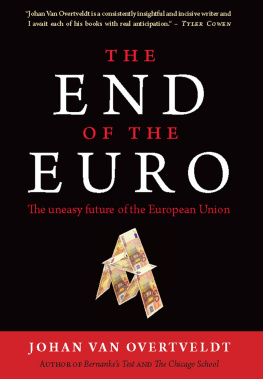Stanford University Press
Stanford, California
2017 by the Board of Trustees of the Leland Stanford Junior University. All rights reserved.
No part of this book may be reproduced or transmitted in any form or by any means, electronic or mechanical, including photocopying and recording, or in any information storage or retrieval system without the prior written permission of Stanford University Press.
Printed in the United States of America on acid-free, archival-quality paper
Library of Congress Cataloging-in-Publication Data
Names: Christensen, Johan, author.
Title: The power of economists within the state / Johan Christensen.
Description: Stanford, California : Stanford University Press, 2017. | Includes bibliographical references and index.
Identifiers: LCCN 2016029014 (print) | LCCN 2016030429 (ebook) | ISBN 9781503600492 (cloth : alk. paper) | ISBN 9781503601857 (ebook)
Subjects: LCSH: Economic policyCase studies. | Fiscal policyCase studies. | EconomistsPolitical activity. | New ZealandEconomic policy. | IrelandEconomic policy. | NorwayEconomic policy. | DenmarkEconomic policy.
Classification: LCC HD87 .C479 2017 (print) | LCC HD87 (ebook) | DDC 330.9dc23
LC record available at https://lccn.loc.gov/2016029014
Typeset by Thompson Type in 10.25/15 Brill
The Power of Economists within the State
Johan Christensen
Stanford University Press
Stanford, California
Contents
List of Tables and Figures
Tables
Figures
Acknowledgments
I WOULD like to thank all the people who contributed to this book. At the European University Institute, Sven Steinmo provided me with great ideas and advice at crucial stages in this project and stimulated me to develop what turned into the core argument of this book. I am also grateful to my colleagues in Florence for the many discussions about the project, in particular Emre Bayram, Pelle Moos, Anna auf dem Brinke, Michael Grtz, Charlotte Haberstroh, Tamara Popic, Raphael Reinke, and Julian Schwartzkopff. Pepper Culpepper, R. Kent Weaver, and Niamh Hardiman also gave me excellent comments and ideas about how to take the project further. At Stanford University, Mark Granovetter provided me with encouraging feedback and invaluable advice about how to turn this into a book. I am also grateful to Woody Powell, Mitchell Stevens, and everyone else at SCANCOR for offering a stimulating academic environment and giving me the time to complete the book. I also benefited from discussions with Paolo Parigi and the graduate students in the Sociology Department. Furthermore, special thanks go to the three reviewersJohn L. Campbell, Monica Prasad, and Elizabeth Popp Bermanwhose critical engagement and extensive comments greatly improved the book.
This study could not have been carried out without the kind cooperation of my interviewees. In all the four countries examined in this book, policy makers were more than willing to share their experiences and insights into the processes behind tax policy change. I am equally grateful to the institutions that hosted me while I was carrying out interviews. At the University College Dublin, Niamh Hardiman, Muiris MacCarthaigh, and Brian Nolan provided valuable contacts and comments as I was carrying out my inquiries. In Copenhagen, the Department of Political Science at the University of Copenhagen offered me an office, and Lotte Jensen at the Copenhagen Business School helped me with contacts. In Oslo, Fafo Institute for Labour and Social Research and director Jon M. Hippe provided support throughout the project. In Wellington, the Centre for Accounting, Governance and Taxation Research at the Victoria University became a home away from home, thanks to David White and Vanessa Borg, whose generosity made my stay in New Zealand a very happy one.
I am also grateful to Margo Beth Fleming at Stanford University Press for believing in this project and for helping me navigate the publishing process, to James Holt for his assistance with the manuscript, and to Margaret Pinette for excellent editing.
Finally, I thank my parents and my sister for their support. And most of all, I would like to thank my wife Elisa for her constant support and encouragement, but most important, for all the good times we have had while this book was in the making.
Chapter 1
Economists and Market-Conforming Reform
IRELAND had already undone itself before the global recession did. In 2007a year before the onset of the international financial crisisthe Irish property bubble burst, and real estate prices that had been growing rapidly for two decades started to plummet. So did the tax receipts from property transactions, which suffered a drop of 36 percent in 2008. The loss of tax revenue marked the beginning of the Irish fiscal and economic crisis. The meltdown that followed was of historical proportions. Between 2007 and 2010, GDP (gross domestic product) fell by 12 percent, unemployment tripledfrom less than 5 percent to almost 14 percentand a generous bank bailout produced a sovereign debt crisis that forced the Irish government to accept a rescue package from the European Union (EU) and the International Monetary Fund (IMF). The country once known as the Celtic Tigerrenowned for its remarkable economic growth from the mid-1990s onwardswas reduced to one of the P.I.I.G.S., (Portugal, Ireland, Italy, Greece, and Spain), figuring alongside the debt-ridden economies of Southern Europe.
Irelands spectacular boom and bust were intimately linked to the tax policies pursued by Irish governments. Usually the story is cast in market-oriented terms: Irish policy makers used a very low corporate tax rate to attract foreign direct investments and cut taxes on labor to create incentives for enterprise and growth. Yet, a closer look at the Irish case shows that this narrative is misleading. The tax policies pursued by Irish governments from 1980 onwards were not attuned for the most part to market principles; they ran directly counter to them. Whereas conformity to markets implied level playing fields and taxation that was neutral with respect to economic behavior, Irish tax policy was geared toward directing and influencingeconomists would say distortingthe economic choices of households, businesses, and investors. The most striking evidence of this was the Irish property boom, which was driven partly by a wide array of specific tax breaks for investments in the construction of everything from hotels and seaside resorts to multistory car parks and sports clinics. In fact, the tax policies of Irish governments bore a strong resemblance to the interventionist tax schemes that were popular around the world in the 1960s and 1970s.
The Irish tax regime was profoundly different from the policies of another small Anglo-Saxon country on the other side of the globe. New Zealand, to many observers, was the textbook case for the use of market principles in public policies. In the 1980s, it went further than any other advanced economy in lowering tax rates and eliminating exemptions, deductions, and loopholes from the tax code. In stark contrast to Ireland, the governing principle in New Zealand was that the tax system should influence economic choices as little as possible. This principle was applied with remarkable rigor. For instance, New Zealand was the only developed country without tax incentives for private retirement savings and without any exemptions from its value-added tax.
The differences in tax policy among the Scandinavian countries were equally puzzling. Despite its social democratic credentials, Norway adopted a major market-oriented reform of taxation in 1992. Though more moderate in scope than in New Zealand, the reform lowered the top statutory tax rate on labor considerably and introduced a system that was neutral with respect to a number of economic decisions. At the same time, the Norwegian tax system retained features that ran counter to market principles, in particular a very favorable tax regime for housing. Denmark, on the other hand, resisted market-conforming tax policies for a very long time. Despite a series of policy revisions in the 1980s and 1990s, Denmark maintained remarkably high marginal tax rates on labor and high and uneven rates on different types of capital income. As recently as in 2009, a Danish worker on just above average wages paid 63 percent of the last krone she earned in total taxes on laborthat is, 12 percentage points more than in Norway and almost twice as much as in New Zealand.












